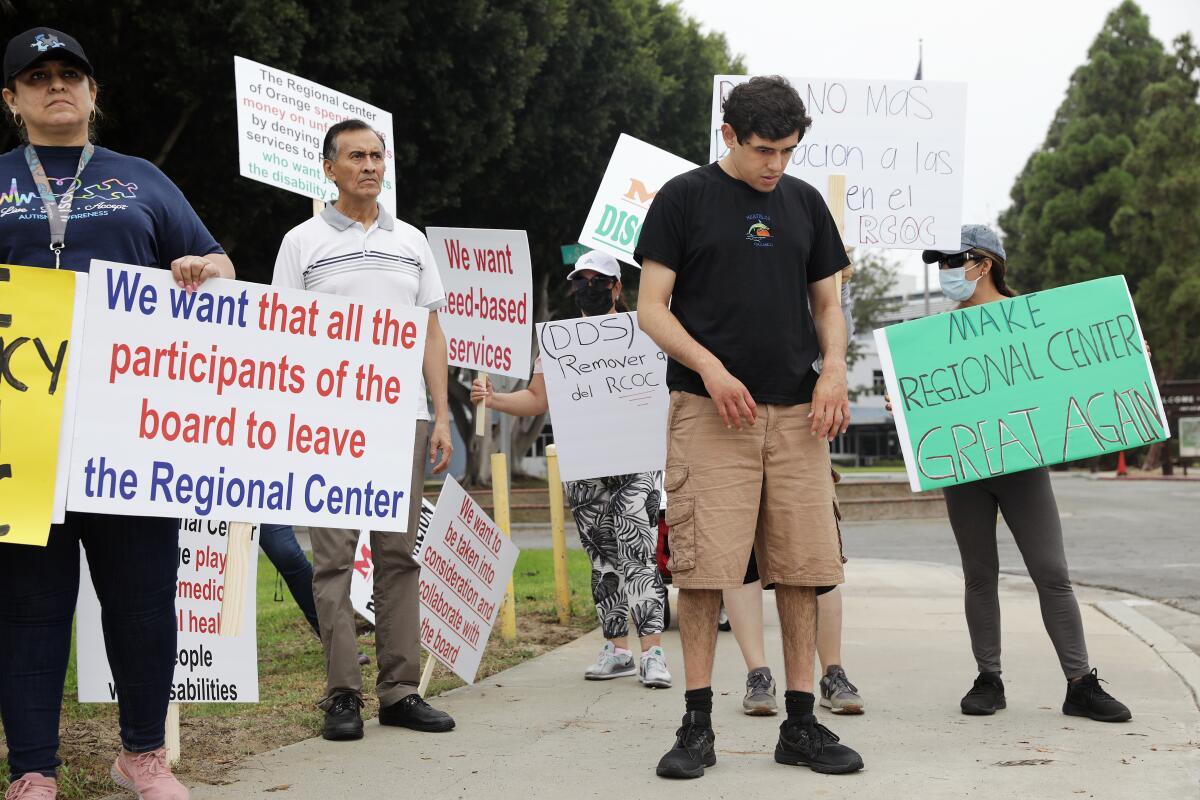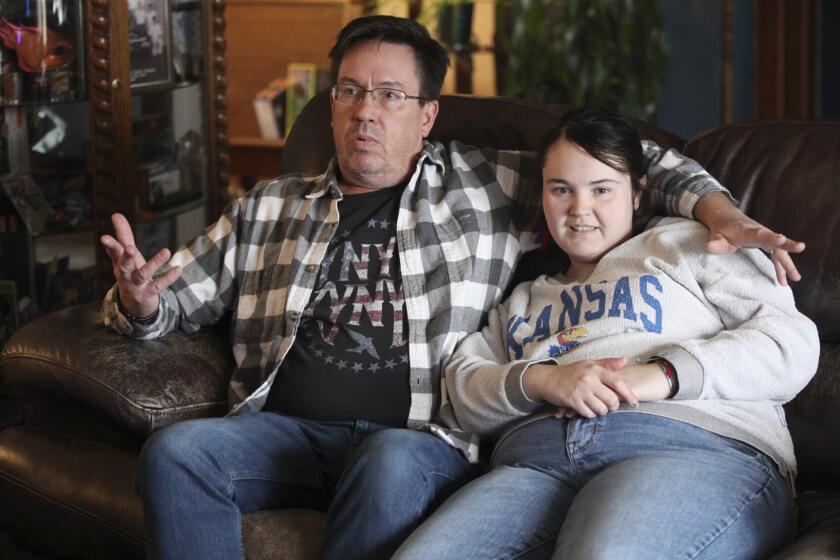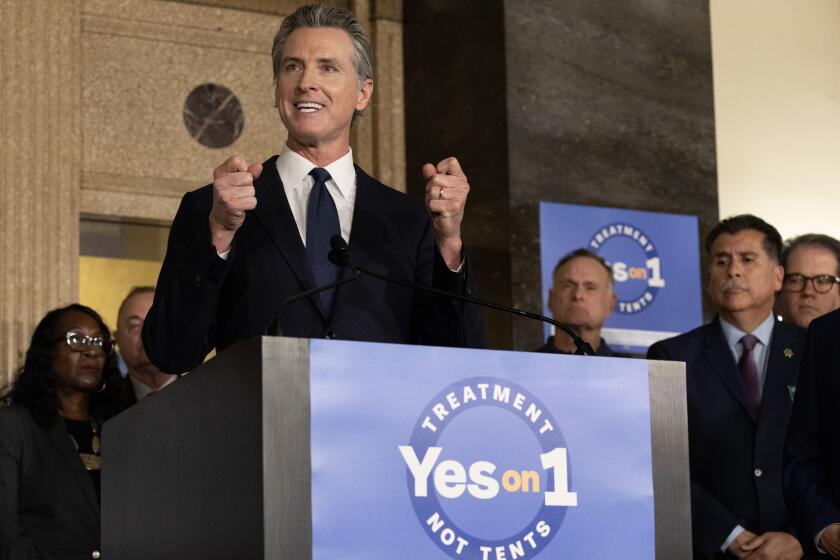California’s proposed budget cuts would leave many autistic young adults without a safety net

- Share via
Kate Movius knew it would be challenging when her son Aidan, who experiences profound autism, turned 22 and aged out of the programs and services provided through his school.
What she didn’t anticipate were the two years she would spend in a fruitless search for an adult program that fit her son. Ultimately, the family ditched the wait lists and created their own form of weekly programming for Aidan and others in the community.
Finding an open space in a program that fit Aidan was made even more difficult by a staffing shortage among service providers, which couldn’t keep up with the demand from the growing developmentally disabled community. That shortage, Movius said, stemmed from the providers’ inability to offer competitive wages.
Pushed by the Lanterman Coalition and other advocates, the state moved in 2021 to phase in higher reimbursement rates for the services provided to the developmentally disabled. This year, however, Gov. Gavin Newsom proposed to delay the final increase to help reduce the state’s budget deficit. Advocates and families say such a delay would only leave essential services further out of families’ reach.
The Moviuses’ recent experiences with Aidan, a now-23-year-old who loves to paint, make music on his Casio keyboard and play sports, illustrates the challenge faced by families with young developmentally disabled adults.
Children with physical or intellectual disabilities are waiting years for state-covered services designed to foster independence and develop job skills for adulthood.
A year before Aidan turned 22, the family started looking for day programs in their Highland Park community, to no avail.
Through its 21 regional centers across California, the Department of Developmental Services evaluates young adults and then refers families to providers who can assist with their specific needs.
Movius’ regional center recommended four programs in her area, but none were feasible because they did not have enough staff to provide one-on-one support. Aidan needs such support because he’s wandered away from his caregivers several times over the years.
“We were told by three of these programs that, while they did serve adults with autism, they wouldn’t accept individuals ‘with behaviors,’” Movius said.
There was one program that seemed promising, but it was right next to a busy street and it didn’t have a security system. Movius didn’t enroll him there out of fear that he would run into the street.
The Moviuses’ solution was to enter the department’s self-determination program, in which a regional center gives money to an eligible adult and their family to spend on programming instead of paying a service provider for it.
Latinos have remained underrepresented in a California program that has been lauded for giving people with disabilities more freedom to decide what they need.
Movius and her husband created an art class for people with profound autism that runs a couple of times a week, giving Aidan much-needed contact with his peers.
Reflecting on the “excruciating process” her family went through, Movius said it was manageable only because she and her husband reworked their schedules and did their best to tag-team Aidan’s care.
“What I would rather for Aidan, though, is that he has a program he can go to with his peers without us, with staff, but no more Mom and Dad,” she said.
The Lanterman Developmental Disabilities Services Act, a state law that passed in 1969, entitles any person with developmental disabilities to the services and support needed to have a full and inclusive life. That right extends to their families as well.
“The state has fallen short of that promise,” said Jordan Lindsey, executive director of advocacy group the Arc of California.
When a family goes to a referred provider, they’re often met with waiting lists with months- or years-long backlogs, Lindsey said. Or they’re turned away entirely because the provider doesn’t have enough staff to support the varying needs of new clients.
Facing a shortfall of at least $38 billion, Gov. Gavin Newsom and legislative leaders said they have agreed to $12 billion to $18 billion in cuts but offered no details.
Staffing levels are low across the state, Lindsey argues, because wages start between $16 and $20 an hour for a difficult, complex job.
A support staffer aids their client with daily life, helps connect them to people and resources in their communities, schedules transportation and works with other service providers.
The providers haven’t recovered from a mass exodus of the workforce during the COVID-19 pandemic, leaving them unable to support the more than 430,000 people who receive assistance through California’s regional centers, Lindsey said.
The Department of Developmental Services pays private contractors to provide residential and day programs, including work and training activities, on a per-person basis using a combination of state and federal funds. But lawmakers recognized in the mid-2010s that the rates — which have been frozen or cut during previous state budget crises — did not support an adequate supply of providers to meet the need, according to the Legislative Analyst’s Office.
To address the problem, the state adopted a plan to raise rates gradually, with the final increase scheduled for July 1. But with another budget crunch looming this year, Newsom proposed delaying the last installment until July 2025 — after the coming fiscal year ends.
“Every time there’s a budget deficit or we have a slowdown in the economy and we’re not receiving state dollars, one of the areas that gets routinely hit is the developmental disabilities system,” said Rick Rollens, president of Rollens Consulting, a government relations and lobbying firm.
Gov. Gavin Newsom crafted the measure to reform California’s mental health system, including a $6.4-billion bond for new facilities.
The proposed delay in the rate increase would reduce state funding for those programs by $612.5 million while sacrificing $408 million from the federal government, resulting in a total reduction of $1 billion, according to the Legislative Analyst’s Office.
This proposed delay places a burden on already challenged regional centers, service providers and staff “who have case loads that are way beyond what they should be in order to serve the community,” Rollens said.
There’s also the added fear that the final rate increase won’t take place next year.
“If the economy continues to go down or we’re faced with the same level of deficit next year, there’s no guarantee that this delay doesn’t turn into a permanent, ‘Sorry, we just can’t give you the money,’ type situation,” Rollens said.
Without adequate staffing, young adults who aren’t getting support are often home without assistance, and parents are left scrambling for care, Lindsey said.
“And [some] parents had to quit their jobs and stay home because there is a 30-year-old at home with significant autism, Down syndrome or cerebral palsy,” he said.
After Aidan turned 22, Movius said, he experienced a few severe crises while she and her husband were searching for a solution. He couldn’t tell them he was depressed, she said, but they saw the signs.
California’s homelessness and mental health crisis is so dire that Republicans and Democrats are leaving their ideological corners and stepping into an unfamiliar middle ground to try to solve the problem.
Movius believes that Aidan missed going to classes with his peers and their daily activities, saying, “there just hasn’t been a replacement for that.”
Aidan “went into this behavioral crisis for about three months,” she said. He was less active, couldn’t access activities that brought him joy and struggled to leave the house — he couldn’t even get into the car.
“His world became so small, and of course, so did ours, it was just these four walls. And he in addition to that was extremely self-injurious,” she said. “It was the longest period ever of any kind of crisis like that for him by a long shot.”
More to Read
Sign up for Essential California
The most important California stories and recommendations in your inbox every morning.
You may occasionally receive promotional content from the Los Angeles Times.



















